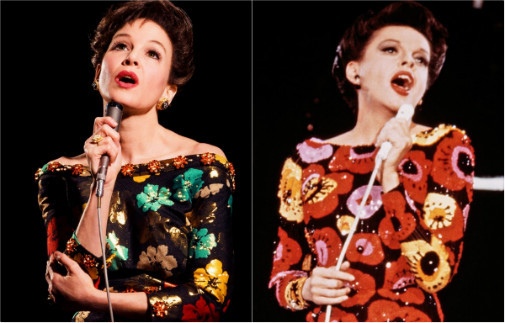by Cláudio Alves

When dressing a real-life story, there’s always a complicated relationship going on between a designer and History. The balance of fact and fiction, raw reality and cinematic fantasy, must be achieved and thought through. Depending on the project, the scales might tip towards one or the other, but both are always dancing hand-in-hand. Such sartorial dynamics might reflect the production’s relationship with fact or even contradict that preoccupation, either supporting an idea of History or silently challenging it.
For Judy, costume designer Jany Temime helped transform Renée Zellweger into Judy Garland, a process that was much more complex than simply looking at archival material and reproducing past fashions…

Temime had to contend with copyright issues that stopped her from directly referencing many iconic looks. Notice how the Gingham dress from The Wizard of Oz never makes an appearance, although very unconvincing versions of the classic sets feature heavily in the 1939 flashbacks. In Judy, Temime dresses Zellweger and young Darci Shaw in styles that Judy Garland might have worn, not what she actually wore. This rhymes well with the actresses’ performances, which evoke Judy while never miming her with exactitude.
The Judy we see in the biopic is refracted through the prism of Zellweger’s star persona as well as her physicality. Judy Garland was very petite and hunched, aged prematurely and full of jittery tics. If you took one of real Judy’s dresses and gave it to Zellweger, it would fit completely different. The final picture wouldn’t suggest the world’s greatest entertainer so much as Bridget Jones in an ill-fitting garment. Because of that, her costumes were tailored to force the actress to bend her shoulders and adopt the right posture. Her trousers and sleeves are often too loose, suggesting the frailty of Garland.

For the stage costumes we see during the Talk of the Town shows, Temime used many reference photos to orient her work. Then, she and director Rupert Goold conceived each look specifically for the song performed and the staging of it. None of the costumes are exact replicas, something motivated, in part, by the demands of the big screen. For example, her bateau collared flower dress references a real piece worn by Garland, but the scale of the pattern is different and the trim around the neckline is more elaborate, perfect to frame Zellweger’s face in tight close-up.
 The way a character dresses can define them. By visualizing how a person wants to be seen, a designer can draw the separation between what one wants to be and what they are. This Judy wants to be seen as a good mother, as a success and a star. When she’s not locked in the privacy of her bathroom, Judy seems to be always putting on a show and all the people in her life are the audience. However, both onstage and off, the artifice is palpable and the costumes can never truly hide the despair beneath the veneer of glamour. A crying clown is always sadder because of its painted smile.
The way a character dresses can define them. By visualizing how a person wants to be seen, a designer can draw the separation between what one wants to be and what they are. This Judy wants to be seen as a good mother, as a success and a star. When she’s not locked in the privacy of her bathroom, Judy seems to be always putting on a show and all the people in her life are the audience. However, both onstage and off, the artifice is palpable and the costumes can never truly hide the despair beneath the veneer of glamour. A crying clown is always sadder because of its painted smile.
At the beginning of the film, when Judy finds herself without a home of her own, she’s wearing a sparkly brocade suit made for the stage. It looks ridiculous in a hotel lobby or a suburban kitchen. Even amid partygoers at Liza Minnelli’s house, she stands out. It’s like there’s a spotlight on her, signaling how she doesn’t belong and that things aren’t all right. Similarly, her last costume, a little black dress, might seem modest but its sparkly textile makes it look more at home on stage than in a restaurant. Whenever she’s not putting on a show, this Judy feels painfully incongruous.

When she is spellbound by the affections of a younger man, her private life turns into a different kind of show with Judy dressing the part of a hip Londoner. Her goofy wedding ensemble, which is inspired by an outfit Judy designed herself, is the clown’s red smile. The glitter and the feathers, they all highlight how Judy Garland is so unlike the role she wants to perform for the world. By dressing Judy according to her aspirations, Temime defines the painful difference between the fantasy of Judy Garland and the reality of this fallen star. The artifice of cinema might not copy fact, but through fakeness, it sometimes finds truth.
